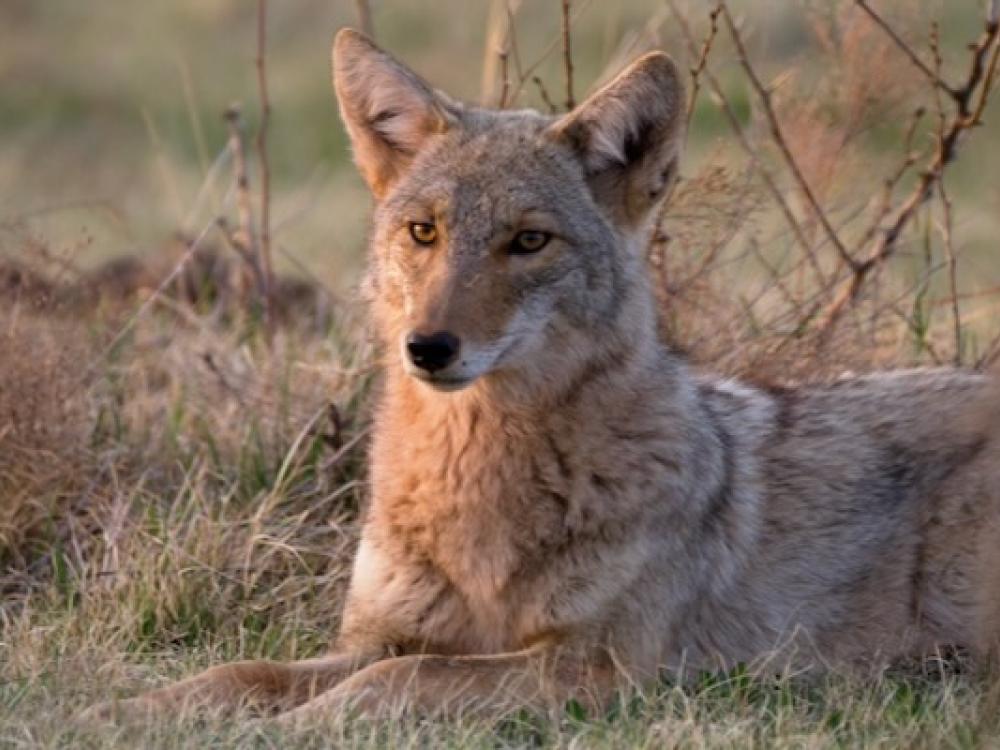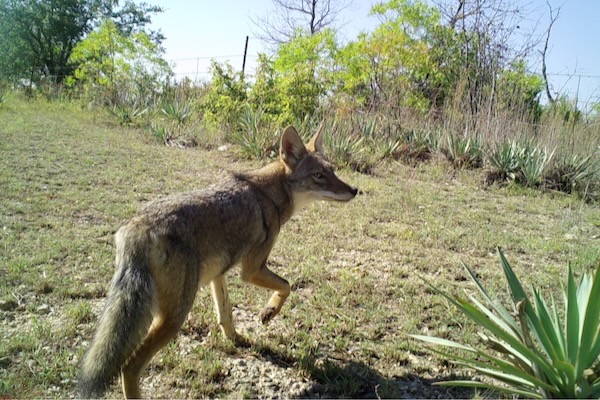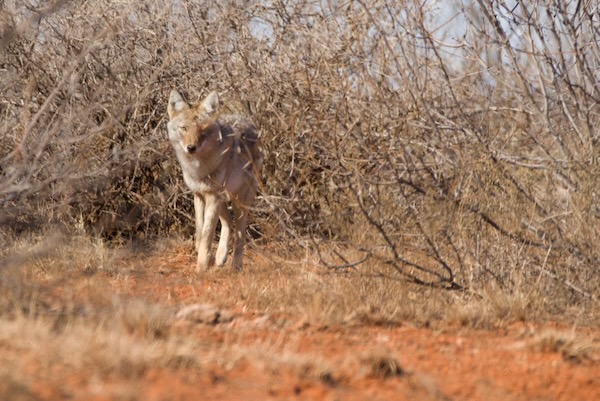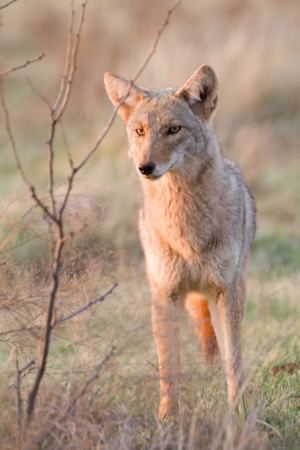
Wildlife advocates share tips for living alongside these 'song dogs.' Above, a coyote spotted in Vernon, Texas. Photo by Laurie Hall.
Aug. 4, 2023
A message was posted on the Nextdoor app for Arlington — someone had found the remains of a cat in their yard and wondered if an opossum had killed it.
The responses had come quickly.
“A coyote, not an opossum.”
There was no way to know how the cat died, but more people began chiming in.
Some had lost small pets to coyotes. Others saw a coyote loping through the neighborhood. Some advised: call animal control.
How common are these suburban coyotes and are they really a problem?
UNDERSTANDING THE 'SONG DOG'
Early American explorers tried to sort out whether they were seeing a small “prairie wolf,” a big fox,or a New World version of a jackal.
Coyotes do indeed look a little like a smaller and more slender version of a wolf, and they’re related.
The coyote, Canis latrans, is in the same genus or group with wolves such as the red wolf, Canis rufus (which has been declared extinct in the wild). Our domestic dogs are Canis familiaris, sort of “cousins” to wolves and coyotes.
 A coyote captured on a trail cam in Parker County. Photo courtesy of Rachel Richter.
A coyote captured on a trail cam in Parker County. Photo courtesy of Rachel Richter.
Coyotes are found throughout Texas. If you look at what citizen scientists (that’s everyday folks) have reported on iNaturalist, there are 542 observations of coyotes in Tarrant County and 534 in Dallas County. Remember, that’s how many times people have reported seeing them, so that’s not how many coyotes live in each county. But over the years, people have seen lots of coyotes in Texas — 7,503 observations statewide so far.
A coyote out in the wild eats lots of rats, mice, birds, rabbits and also insects, fruit and carrion. Those living among people have an expanded menu that could include those roast scraps you put out with the garbage or the pet food on the back porch that your dog didn’t eat.
Coyotes are smart and adaptable, and if we feed them (accidentally or not) we make it more likely that coyotes will become a problem for us.
For many of us, sitting out in a prairie somewhere at sunset listening to the yipping and howling of distant coyotes is a thrilling, wonderful experience. Calling them “song dogs” is an affectionate way to recognize those nighttime serenades. In The Mammals of Texas (Revised Ed.), David Schmidly says that coyotes are “among the most vocal of all North American wild mammals” (p.143). He says that their nighttime calls are most often for the purpose of announcing their location and any hunting success to other coyotes.
I talked with Rachel Richter, the Texas Parks and Wildlife Department Urban Biologist for Tarrant County and several counties to our west. She said that the peak breeding season for coyotes is around Valentine’s Day (cards and roses are presumably optional), and typically four to seven pups are born around April. She said, “The only time coyotes will use a den is when they have pups – the rest of the year they don’t use a den.”
OUR RELATIONSHIP TO 'OLD MAN COYOTE'
 The coyote has been portrayed as sneaky and cowardly in American popular culture. Aztec mythology portrayed them as a hunter, shape-changer, trickster and venerable old man. Pictured a coyote in Vernon, Texas. Photo by Laurie Hall.
The coyote has been portrayed as sneaky and cowardly in American popular culture. Aztec mythology portrayed them as a hunter, shape-changer, trickster and venerable old man. Pictured a coyote in Vernon, Texas. Photo by Laurie Hall.
People have lived close to coyotes ever since there have been people in North and South America. In what would become Mexico, coyotes lived among Aztecs who called them “coyotl,” basically the name we continue to use for this little wolf cousin. The coyote entered their mythology as a hunter, a shape-changer, a trickster, and a sort of venerable old man, according to Dan Flores’ book, Coyote America: A Natural and Supernatural History.
In our recent popular culture, he appeared as Wyle E. Coyote, the cartoon trickster whose attempts to catch the road runner always backfired.
But fur-trappers and ranchers in the late 1800s and early 1900s saw Old Man Coyote differently. His fur made coyote skins a source of revenue. For sheep ranchers, he was a threat to livestock. It did not help that in popular culture the coyote was portrayed as sneaky and cowardly. Mark Twain (quoted in Flores’ book) described the coyote as having a “furtive and evil eye.”
Travelers, traders and settlers began putting strychnine in animal carcasses for coyotes to find. Strychnine is a deadly poison, killing by inducing extreme convulsive cramping and eventual asphyxiation after terrible suffering. A federal program, the Bureau of Biological Survey, became a vehicle for eradicating predators. Names and bureaucracies change, and eventually the Biological Survey became the Division of Wildlife Services. And poisoning techniques shifted to include the use of the M-44 cyanide bomb.
The spring-activated device delivers a dose of cyanide powder to targeted animals. But this cyanide bomb is not “targeted;” it sprays cyanide into the face of any animal (or human) that pulls at it. The Center for Biological Diversity describes the effects of such poisoning as internal bleeding, failure of the lungs, seizures, and then death. The organization reports that these bombs are responsible for the temporary blinding of a child and the killing of three dogs. The use of M-44s is still legal, though there have been efforts to ban their use on public land.
Poisoned, trapped, aerial gunned and killed for bounties and in contests, more than half a million coyotes are slaughtered every year in the U.S., according to Project Coyote.
Nevertheless, Old Man Coyote had a few tricks up his sleeve. One is that coyotes are not committed to living and hunting in packs. Coyotes are among our most adaptable, clever and resourceful wildlife. They are very social animals and like to live in family groups but are able to function as lone hunters and live among people while attracting little attention.
Another survival strategy is what TPWD biologist Rachel Richter said is called “density-dependent reproduction. Basically, when their numbers get low, they have more babies.”
As more coyotes were shot and poisoned, litter sizes went up. And programs designed to eradicate predators will get rid of the coyotes’ competitors and allow the populations of prey such as rabbits, mice and rats to grow. Coyotes have expanded their range all across the U.S., and there are stories of coyotes in New York’s Central Park.
LIVING ALONGSIDE COYOTES
 A coyote cautiously surveys the scene near Wichita Falls. Photo by Laurie Hall.
A coyote cautiously surveys the scene near Wichita Falls. Photo by Laurie Hall.
Urban and suburban coyotes are, in many places, a relatively recent thing, and the challenge is for us to safely live alongside them. Project Coyote is devoted to humans coexisting with wildlife (and particularly carnivores). One of its programs advocates for the reform of the U.S. Department of Agriculture’s Wildlife Services program mentioned earlier in connection with cyanide bombs. Another program urges an end to wildlife-killing contests.
Another organization studying these animals is the Urban Coyote Research Project. Their website has data-based information about coyotes and practical information for coexisting with them when possible. Their information about avoiding conflicts with people mirrored what TPWD’s Rachel Richter told me.
Coyotes typically navigate neighborhoods and parks without being seen, with people occasionally getting a short look at one moving from place to place. But serious incidents do happen from time to time.
Last year a Dallas toddler was bitten and dragged down the steps of his porch by a coyote. Reportedly, people had been feeding coyotes in the area. About five years ago there were several incidents with an aggressive coyote in Frisco.
Such attacks are rare. We are much more likely to be injured by a domestic dog than by a coyote. And there are things we can do to keep coyote attacks rare. Here's what experts recommend as ways to insure that coyotes see us as something to stay away from:
HAZING
If you see a coyote that seems unafraid or is not running away, make yourself scary. The technique known as “hazing” involves yelling, waving your arms, making noise and not backing down. Some suggest shaking rocks inside a can. One useful thing, said urban biologist Richter, is to use a large black trash bag “and shake it or let it billow out — they really don’t like that.”
At the same time, don’t create a conflict where there was none. If you see the animal from a distance or it is already running from you, hazing is not necessary. If the coyote is not running away because it appears to be sick, leave it alone and report it to your city’s animal control or TPWD.
“The key with hazing is that you have to keep it up until the animal leaves the area,” advised Richter.
If you yell and create a commotion but stop while the coyote is still there, it may conclude “that was strange” and then go about its business without a reason to change its behavior. But, she said, “always make sure that the animal has a way out,” in other words don’t corner it.
An additional tip, one that may be difficult in a scary encounter, is do not run away from the coyote. Much like a dog, they have a strong tendency to chase anything that runs away.
DON’T FEED THEM
Never feed coyotes. Richter said she had heard stories of golfers carrying dog treats to offer to coyotes. People also may unintentionally feed them by leaving pet food outside or not securing their trash. In one case she said that a barbecue place had not secured their dumpster and coyotes were snacking on brisket.
"The biggest reason why coyotes start acting like they’re not scared of people or being too bold is because they’re being fed, whether that’s intentional or unintentional,” she said.
So we should make sure animals cannot get into our trash, and also if a pet dish is outside, take any leftovers inside.
BE AWARE OF BOUNDARIES IN PUPPING SEASON
 Coyote in Vernon, Texas. Photo by Laurie Hall.
Coyote in Vernon, Texas. Photo by Laurie Hall.
Spring may bring new behaviors, Richter said.
“In April and May, coyotes that were previously never an issue might suddenly approach people walking their dogs. That might be an indication that a den is nearby.”
She said you can still haze that coyote if it is too close or too bold, but be aware that coyotes are especially defensive about nearby dogs at such times.
THE BOTTOM LINE
Richter said education is key to coexistence with coyotes.
“Most people, once they’re armed with information, feel comfortable that they can live alongside the coyotes in their neighborhood.”
Some others are not reassured and often want a coyote trapped and relocated.
"Relocation is, in almost all scenarios, not legal with coyotes in the state of Texas,” Richter said.
This is primarily because of laws regarding rabies quarantine; the TPWD website says it is a Class C misdemeanor to relocate them within the state.
Removing coyotes (by relocation or by lethal control) generally does not solve the problem. More coyotes will move in to take their place. If we can change our own behavior — don’t feed them, keep our pets from running loose, haze a coyote that is too bold — the coyotes’ behavior should change accordingly.
RESOURCES
People who need information or technical guidance can reach an urban biologist using the Urban Wildlife page of the TPWD website.
TARRANT COUNTY
Rachel Richter
rachel.richter@tpwd.texas.gov
972-293-3841
DALLAS COUNTY
Sam Kieschnick
sam.kieschnick@tpwd.texas.gov
972-293-3841
Stay up to date on everything green in North Texas, including the latest news and events! Sign up for the weekly Green Source DFW Newsletter! Follow us on Facebook,Twitter and Instagram. Also check out our podcast The Texas Green Report, available on your favorite podcast app.









